Everything You Need to Know About Infrared Thermometers
Infrared thermometers offer a unique advantage over other tools: they have the ability to measure temperatures from a distance, without the need for direct contact. This feature makes them invaluable in various industries, from food service to manufacturing. But before you invest in an infrared thermometer, it’s crucial to understand their applications, use cases, and how to select the right model for your needs.
- Why Use Infrared Thermometers?
- Choosing the Right Infrared Thermometer
- Getting the most from Your Infrared Thermometer
- Frequently Asked Questions
Why Use Infrared Thermometers?
➤ Measure Temperatures from a Distance
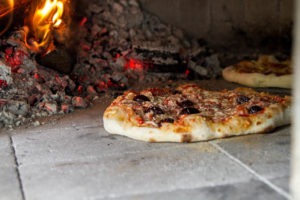
Infrared thermometers are ideal for situations where direct contact is impractical or dangerous. These genius devices provide accurate temperature readings from afar—just point and shoot!—which is especially useful for:
- Fragile items: such as computer circuitry
- Hazardous objects: like molten metal, gears, and fiery griddles
- Hard-to-reach areas: such as air conditioning ducts or high shelves
- Moving targets: like conveyor belts or living organisms
- Contamination-sensitive materials: including buffet lines and prepared dishes
➤ Quick Surface Temperature Readings

Infrared thermometers are designed to measure surface temperatures accurately and quickly. They typically provide readings in a fraction of a second, which is vital in fast-paced environments. Their speed and ease of use make them essential tools in food service, manufacturing, HVAC, and many other fields.
Choosing the Right Infrared Thermometer
Selecting the right infrared thermometer depends on your specific needs, and ThermoWorks offers a range of models suitable for different applications. Download our handy chart or read our online buying guide to find the best infrared thermometer for you—or shop one of our crowd favorites below.
➤ Best-Selling Infrared Thermometers
Getting the most from Your Infrared Thermometer
➤ Learn How Infrareds Work
One common misconception is that the laser pointer in an infrared thermometer measures temperature. In reality, the laser is a guide to help you aim. The thermometer measures infrared energy from the surface area around the laser point, not directly from the laser spot itself.
➤ Know What to Measure
Another myth is that infrared thermometers can read internal temperatures. These devices are designed for surface temperature readings only. For internal temperatures, such as checking if meat is cooked properly, a traditional probe thermometer is necessary.
Infrared thermometers can measure the surface temperature of pizza stones or cookie sheets. However, they can’t measure the ambient (air) temperature inside your oven or smoker. For that, use a Pro-Series® Air Probe.
➤ Understand Emissivity
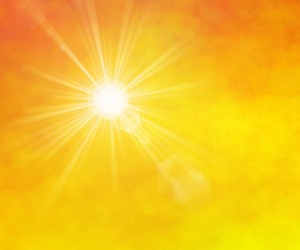
Emissivity is the ability of a material to emit infrared energy. Different materials have different emissivity levels, affecting the accuracy of infrared thermometer readings. For instance, shiny metals have low emissivity and can reflect ambient infrared energy, leading to inaccurate readings. Whereas most organic materials have high emissivity, making them suitable for accurate infrared measurements.
Learn more about the emissivity of various materials here.
➤ Check Grill Temperatures

- Place a cast iron plate or skillet on the grill and preheat for 5-10 minutes.
- Spray the surface with cooking oil to ensure proper emissivity.
- Measure the surface temperature of the plate or skillet with your infrared thermometer.
➤ Measure Liquids
To measure the temperature of liquids like soups and sauces, stir vigorously before taking a reading to ensure the surface temperature is uniform and an accurate reflection of the entire pot. Be cautious of steam, which can affect the accuracy of your measurements.
Frequently Asked Questions
➤ Can Infrared Thermometers See Through Glass or Water?
No, infrared thermometers cannot see through glass or water. They only measure the surface temperature of these materials.
➤ What is Spot Size and Distance to Target Ratio?
The spot size refers to the area measured by the infrared thermometer, controlled by the distance to target ratio. For example, a 12:1 ratio means the thermometer measures a 1″ diameter area from 12″ away.
➤ Do I Need to Clean My Infrared Thermometer?
Yes, keeping the lens clean is crucial for accurate readings. Use a soft cloth with water or alcohol, and avoid submerging the thermometer in water.



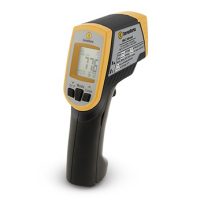
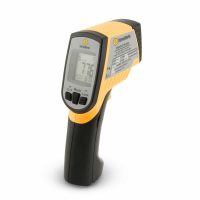
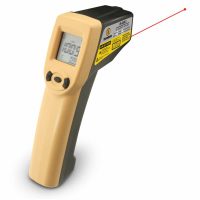
Informative and well written!
Most thin film plastics are highly transmissive to the wavelengths measured by IR Thermometers. Because the thin film plastics are not 100% transmissive the resultant temperature will be incorrect unless it is in intimate contact with the frozen food.
Also attempting to measure the temperature of surfaces with emissivities lower than .95 can result in gross errors, especially when surrounding environments have temperatures significantly different than the average indoor ambient (20˚C , 68˚F), i.e. temps taken inside refrigerated areas, or near open ovens etc.
Exactly! And that’s why we make thermometers with adjustable emmisivity.
recipes call for medium heated pan – what temp is that
About 325°F.
Thanks for sharing the useful information. Keep posting such kind of blogs as they are really informative, wish you good luck for your future blogs. Keep it up and keep sharing.
Its stated that the IR thermometer doesn’t pass through water. But it also says that a stainless steel pot of boiling water measures to low when the emissivity is not set correctly to adjust for the higher reflection of the shiny metal. But why should that have an effect if the IR can’t see though water? Also, if I have a stainless steel pot of heated oil do I then have to adjust emissivity for the steel pot or leave it at .95?
That was a bad example that I have corrected. A bare shiny metal pan without water is the better example.
The way the previous example makes sense is if you were taking the temp of the outside of the boiling water pot. Then you’d need the right emissivity for the metal.
i want to measure the surface temp of 3 of my cooking pans: non-stick (dark), cast iron (dark), and stainless steel (polished/reflective). any suggestions for emissivity settings on infrared gun?
Jim,
Check out our emissitivy table here! But 0.95 is good for cast iron, 0.59 is good for stainless steel. The nonstick is probably mid ninties, but I’d put a drop of oil down on the pan and temp the oil at 0.95.
What is not provided is an understanding as to the variance from actual that a emmissivity setting might deliver. Say stainless pan at .95 will deliver a reading of X. The same pan at a .59 will deliver a reading of Y. Then repeat again with oil and compare.
I haven’t done that work thoroughly, but I know that the difference between a .59 an .95 emissivity can be WIDE. Like, 50°F+ wide.
Can you use one of these to determine the temperature of a car interior?
You can use it to temp a surface in the car, form which you can infer air temp, but IR thermometers can’t “see” the air to take its temperature. Knowing what emissivity to use may be tricky.
This article on using an infrared thermometer was super informative! I’ve always been a bit unsure about how to use one properly, and this cleared up all my doubts. The step-by-step guide and the video demonstration were extremely helpful. Now I feel confident using my infrared thermometer for various applications, from cooking to home maintenance.
Great post! Most information on IR sensors talk to what it can do, but don’t cover what they can’t do which is in many ways more important!
I would like to find a way to measure the temperature of my pan before I add oil, then the temperature when it has oil in it. I want to ensure the pan is ready for the oil. I want to make sure the oil tempis ready for the food, but not about to burn. I would also like to know the temperature of the pan while I am cooking.
I mainly use All-Clad copper core stainless steel pans. I understand this is not an ideal surface for IR temperature measurements. Is there any reasonable way to do this or is the IR just not a good solution for this. For example, can I enter the Emissivity value for those different measurements then expect to get a somewhat reliable measurement for what I want to do (not burn the oil/butter…). Or is there a better way to do this.
In reading your post, I was not sure if putting a liquid in a stainless steel pan made it so a measurement could be made. You gave an example of a stainless steel pan with boiling water. At first I thought you were talking about measuring the water temperature. But I think you were talking about the outside of the pan and the boiling water was just a way to ensure the outside the pan was at a certain temperature (212 F).
Thank You!
Using just a few drops of oil creates a surface that the IR can read accurately at it more “normal” emissivity settings. If your IR has an adjustable emissivity, change it for stainless steel, then you can measure directly. You can put the oil in when the pan is cold and chekc it with the IR until it gets up to temp, but it won’t work with water, which has strange surface conditions that give inaccurate readings.
So if a surface has an emissivity rating of 0.50, does that mean that the actual surface temperature is twice as high as the reading on the IR gun?
No, it means that half the light entering the IR gun is due to heat as opposed to reflected light. How that converts to a temperature is a mathematical algorithm that the processors in thwe thermometer carry out. It is not a correlation of just multiplying by the constant.
What temp should a cast iron pan or flat grill be to get a good sear on meat?
Anything above 375°F will technically do, but we don’t like to put meat to pan until 425°f if possible.
Is the angle between the instrument ( I have a IRK-2) sight axis and the normal to the surface important? I want to measure the surface temperature of the ceramic plate inside a pizza oven attachment on my gas grill. The attachment has a metal hood forming the oven such that the ceramic plate can only be seen thru the open side. Thus the angle between the instrument and the normal to the ceramic plate is estimated to be 75 to 85 degrees. Will this affect the reading? Will the shallow angle between the plane of the ceramic plate and the instrument produce error due to reflections from the hood?
For readings over a small area, having a normal angle of 90°F is important, as the reading will cover the smallest area—a circle. But if the angle is off-normal, you get a reading of an ellipse, expanding the reading area. That’s fine, and you’ll get an accurate reading over that area, but you just ned to know that that is what’s happening.